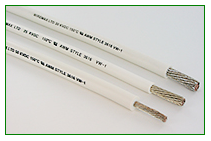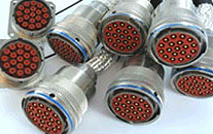Connectronics’ Outlook 2016
The excitement of new possibilities always presents 
Our focus on the aerospace and military industries will continue throughout the year as we remain committed to meeting the needs of such a high tech industry. Both industries expect to see continued growth as more manufacturing and innovations continue throughout the year. As technology increases, we will be ready to deliver products for the measurement systems used to keep operations running optimally and safely.
As we discussed in a previous post, specialized electronic systems require state-of-the-art components to handle the multiple functions of innovative aerospace and military designs. Heading into 2016, we are working on expanding our product lines to tackle even more technologically advanced electronics. For example, our SCID series is a redesigned connector system that runs at 30 KVDC operating voltage to handle higher operating conditions. The Nano MIGI hardnose connector is also redesigned to improve the functionality of this high voltage connector.
Wiremax, a Connectronics brand, will also continue to produce the high voltage products that companies have relied upon for years. Wire and cable options from Wiremax, such as Tuffsil Silicon Wire, SIL-Koat Wire, and high voltage wire products can be found on both the Connectronics and Wiremax websites. Ordering is available from both Toledo manufacturing facilities.
We are looking forward to continued success in supplying the specialized connectors and interconnection systems for aerospace and defense industry measurements systems. The radar systems, mass spectrometry units, specialized helmets, and all the other analytical instruments required to deliver efficient and effective operations can rely on the continued dependability of Connectronics and Wiremax components.
From all of us at Connectronics, we wish you a happy new year!
On Land, In Water, Up Above: Our Products Are Everywhere!
Look around and nearly any place you encounter will have specialized connectors, cables and interconnection systems, many of which we
Take a look at some of the examples we’ve pulled from the many places you can find them:
• On land: Connectronics products are components of heavy vehicle simulators (HVS), complex cable systems and instrumentation used in a variety of industries, including science-related industries such as: research sciences, pharmaceutical and biotech. Components and connectors can be found in mass spectrometers, which measure and weigh molecules, and the pharmaceutical industry. This industry uses our connectors in quality control (QC) systems to ensure the purity of pharmaceutical products. More examples of the wide range of applications for Connectronics products also include: titanium smelting plants, nuclear reactor systems in the energy sector, and stage lighting for the entertainment industry.
• In water: To measure and monitor water quality, biologists and municipalities all over the world use Yellow Spring Instruments, which include Connectronics components. Our underwater cables and connectors are used for offshore oil exploration too!
• Up above: Connectronics manufactures high voltage connectors and avionics for the commercial and military aviation industries. You’ll also find our products in radar systems used on private jets and other aircrafts. The aerospace industry also utilizes our systems for airport traffic control and communication. Our connectors and cable assemblies are also in space. We build cable assemblies for xenon-ion propulsion thrusters that are onboard space-bound satellites, abiding by special requirements for aerospace cable assemblies. Systems must be able to operate in extreme temperatures. They must also offer reliability throughout the lifespan of a satellite mission.
Learn more about our company, our products and the industries we serve by visiting our website. If you have any questions, call us at 800-965-0020 or email us at info@connectronicscorp.com.
The Efficiency of Time of Flight Mass Spectrometry

This process is preferred method of discerning chemical compounds present within a substance or molecular structure. Although the principles of the process have been widely recognized since the development of the cathode-ray tube in the 1880s, contemporary advances in technology and design have brought this method of atomic analysis to new heights.
Time-of-flight mass spectrometry is the latest evolution of the technology. Unlike traditional spectrometry utilizing electromagnetic energy to put velocity on and examine a spectrum of particles, time-of-flight mass spectrometry employs a different process.
What is conventional mass spectrometry?
In traditional mass spectrometry, a sample substance is super-heated inside a tube until it becomes a gas, and the gas produced is then ionized—meaning atoms either gain or lose electrons—using an electron beam. Through a series of strong electro-magnets, the ionized particles of the test material are sent careening around a bend in the tube where they are collected on a specialized screen called a detector depending upon their weight, or mass. As larger particles with greater mass travel at slower speeds than lighter particles with less mass, a spectrum is established. This pattern, or isotropic structure, is then analyzed in order to determine molecular composition and arrangement. Every substance generates a specific pattern unique to that substance.
How does time-of-flight mass spectrometry differ?
In time-of-flight mass spectrometry, a sample of material to be tested is ionized with a laser beam within the spectrometer. These high-velocity ions are accelerated through the cylinder with the use of a system of varying electrical charges as opposed to magnets.
As the particles move through the spectrometer at varying speeds depending on their mass—the mass/charge ratio is once again the dynamic at play—those particles/ ions with more mass will, again, move slower than those with a lower mass.
As the particles form a flow depending on their speed, they form an ion beam and produce a profile which is captured by a detector and analyzed for its elemental composition and structure. This chemical profile, based on the atomic data from the elements in the sample, is also unique to the substance being analyzed.
How does the Connectronics CSCB Coupler Series use time-of-flight mass spectrometry?
The Connectronics CSCB single conductor, high voltage, bayonet coupling connector series is a super-shielded precision connector. The CSCB provides maximum voltage operation, ranging from 20 kVDC or 6.6 kVRMS, and is capable of functioning in small-space and extreme environmental conditions (-55ºC to +125ºC, sea level to 70,000 ft.). The design features a tapered interface allowing corona resistant operation. The “Positive Lock” mating retention system of the spring-loaded bayonet coupling nut gives a quick, reliable, quarter-turn lock. An additional benefit of the CSCB series is their reliable, consistent, durable design which is vibration and shock-resistant. CSCB receptacle connectors are hermetically sealed to maintain integrity and are conveniently panel-mounted.
CSCB connectors and interconnectors provide unparalleled reliability and performance in many applications and are at the cutting–edge of time-of-flight mass spectrometry. An application where utmost accuracy of time-of-flight information and measurements are imperative is in medical and pharmaceutical research and development. Having the ability to determine precisely the amounts of elements and compounds present in a substance could easily mean the difference between life and death—or liability. Connectronics CSCB connectors and interconnectors are the strongest link in this research process.
More specific information, technical data, and ordering procedures can be found here.
(Source: Davis, Frey, Sarquin & Sarquin. Modern Chemistry. Holt, Rinehart & Winston. (Austin, TX: 2006) Pp. 3-84.)

